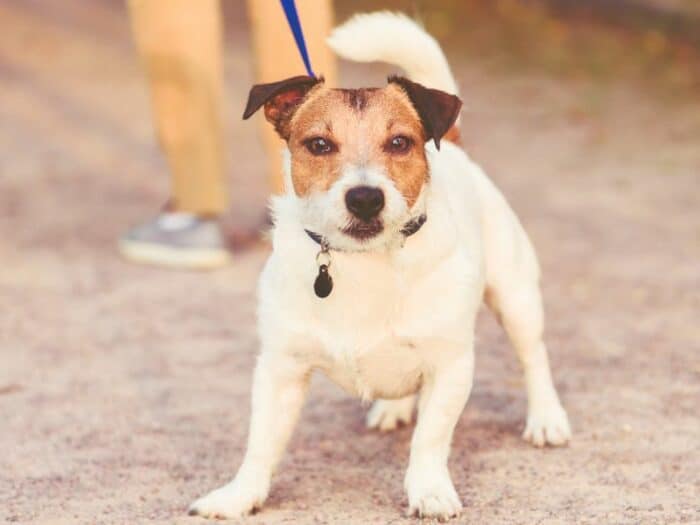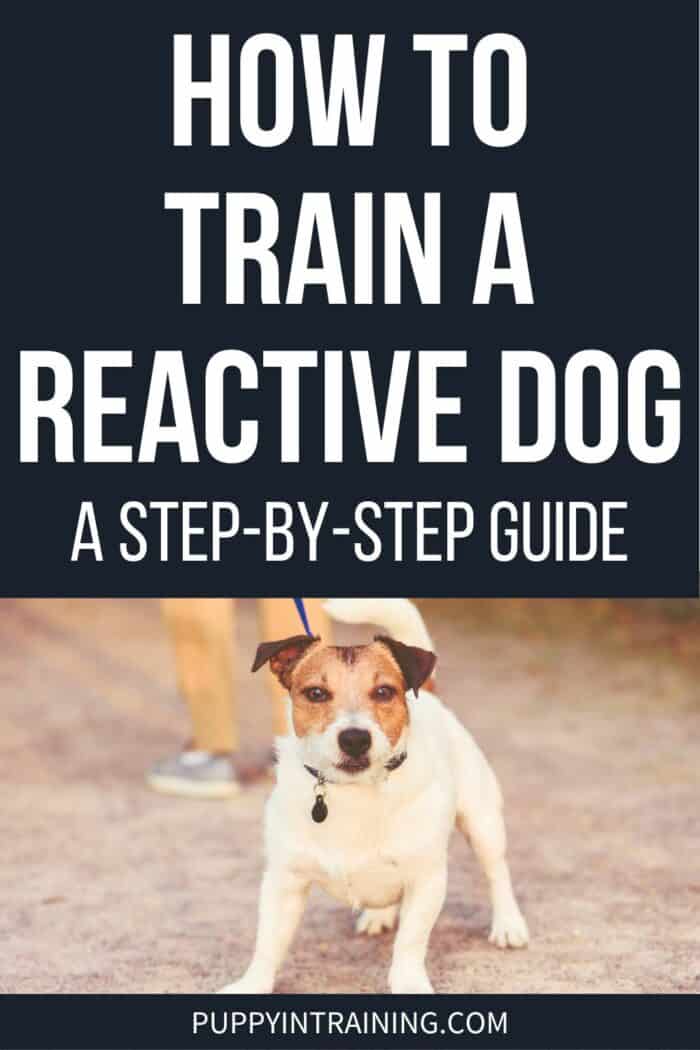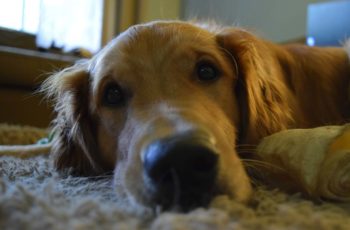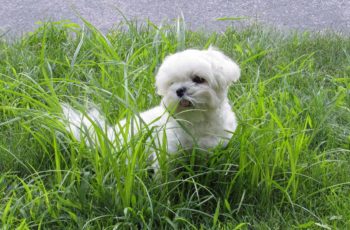This post may contain affiliate links. We may earn money or products from the companies mentioned in this post.
Many misconceptions and stigmas are associated with the phrase “reactive dog.”
For those that love a reactive dog, this can make advocating for their dog and seeking help more difficult.
But, with management and conditioning, a reactive dog can live a safe, happy, and fulfilling life.
As someone who has owned, fostered, and worked with several reactive dogs over the years, I understand the frustration firsthand.
Here are the basic steps for how to train a reactive dog:
- Identifying Your Dog’s Triggers
- Learning to Read Reactive Dog Behavior
- Use Positive Reinforcement to Recondition
- Readjust to the New Threshold Line
- Continue Gradually Moving Forward
Keep reading to learn more about reactivity in dogs and more details on our step-by-step approach.

What is Reactivity in Dogs?
Before we dig into the training, we should start with the basics. What is reactivity in dogs?
Reactivity doesn’t mean that a dog wants to or enjoys acting out in the presence of a trigger.
Instead, it indicates that your dog is so stressed, anxious, or overwhelmed by the trigger’s presence that their reaction escalates into unwanted behaviors.
Consider the young child who, unable to tell you that a situation is uncomfortable, starts to have a meltdown to express their discomfort.
Your reactive dog is responding in the same way.
Reactive behaviors are often viewed as aggressive, but you may also notice your dog becoming overwhelmed and shutting down.
This is a response frequently seen in shelter environments, where dogs are stressed to the point that they hide in the back corner of their kennel, failing to acknowledge people nearby.
The most important thing to remember with a reactive dog is that these behaviors don’t mean your dog can never be a loving, family pet.
Reactivity is a sign that your dog is having a hard time in that situation and doesn’t know how to respond in a healthy way.
As their owner, it’s your job to help condition your dog to better respond to their triggers.
Not only will this make life with your dog more manageable, but it’s also crucial for your dog’s mental health!
What Are the Signs of a Reactive Dog?
One question that I often hear is, “How do I know if my dog is reactive?” The answer is simple – watch for the signs in your dog’s daily behavior and body language.
The most straightforward definition for a reactive dog is that they become so obsessed and preoccupied with their trigger that they can no longer be handled or moved out of the situation to safety.
This includes dogs reacting outwardly by barking, lunging, or growling at their triggers.
It also includes dogs that are internalizing their reactivity by shutting down.
Does that internalize their reactivity may be seen shaking, whining, pacing, or trying to hide, all while failing to listen to their usual obedience commands.
Reactivity vs Aggression
The terms “reactivity” and “aggression” are often used interchangeably, but they have different meanings. It is important that we understand the difference between the two.
A reactive dog is not automatically an aggressive dog. But reactivity that isn’t addressed and managed can turn into aggression.
Your dog’s reactive response is a sign of feeling overwhelmed or frustrated.
If that frustration continues to build up, it’s like a pot of water on the stove – it will eventually boil over. This is when they cross the line from reactivity into aggression.
Some common aggressive behaviors include snapping, muzzle punching (when your dog hits a person or animal with their nose, mouth closed), and biting.
We are working with our youngest dog Lucifer on his reactivity toward strangers. He is a good example of the difference.
In most situations where a stranger is present, he barks and growls while hiding behind me for that feeling of comfort and safety.
Suppose we let those behaviors continue to grow and continue without addressing the behaviors or the situation.
In that case, he could be pushed over the line into aggressive behavior, creating a bite risk.
What Causes a Dog to Be Reactive?
There are a lot of myths and misconceptions when it comes to the cause of reactivity in dogs.
A reactive dog does not necessarily mean that you, as an owner, did something wrong.
A variety of different things, including genetics, can cause reactivity. This means your dog could simply be “wired that way.”
Some other potential causes for your dog’s reactivity include lack of socialization, lack of training to teach self-control, or an experience that was frightening or traumatic (such as being attacked by another dog).
Some dogs are reactive from a young age, but the fact that you didn’t adopt a reactive puppy doesn’t mean that you won’t struggle with reactivity at some point in the future.
Many dogs don’t show signs of reactivity until they are adults.
How to Train a Reactive Dog
Dog training for reactive dogs should never rely on aversive training methods or punishment.
These dogs are often responding to fear or anxiety. By introducing a negative response to that behavior, you will only build further upon those negative emotions.
The most effective way to address reactive dog behavior is by focusing on desensitizing and conditioning your dog to react differently to the trigger.
For example, if your dog demonstrates leash reactivity when in the presence of other dogs, the goal would be to introduce a new way to respond to dogs on a leash.
This is a slow and gradual process that will take time to implement.
Step One: Identifying Your Dog’s Triggers
Before you can condition your dog to respond differently to their triggers, you need to figure out what triggers set them off.
Reactivity can be associated with anything that could cause excitement or fear for a dog.
Their trigger could be a physical thing or a specific situation. Some examples of more common triggers include:
- Other dogs or animals
- More specifically, unknown dogs
- Strangers
- A specific gender
- A physical feature, like men with beards or people wearing hats
- Vehicles
- Feeling cornered
- Being on leash/the feeling of being trapped on leash
Your dog may have one trigger, or they may have several. Our youngest dog Lucifer came to us unsure about strangers and reactive to men.
But we learned that some more specific sounds or triggers also upset him, like the ‘click’ sound of a smartphone camera.
The more you know and understand your dog’s triggers, the better equipped you are to work with them to overcome this hurdle and move past it.
Step Two: Learning to Read Reactive Dog Behavior
Your reactive dog will exist in two states: under-threshold and over-threshold.
To avoid an unpleasant or potentially dangerous situation, the goal is to keep them under-threshold whenever possible.
Under-threshold refers to the moment when a dog is relatively okay.
They may notice their trigger or even be a little unnerved by its presence, but they aren’t freaking out or shutting down. This is the ideal window to train a reactive dog.
When a reactive dog goes over-threshold, they may exhibit any combination of the following behaviors:
When considering dog training for reactive dogs, the sweet spot is when your dog is aware of the trigger being present and slightly out of their comfort zone but hasn’t crossed that threshold line.
Watch for signs that your dog is eyeing the trigger and showing discomfort.
This includes obsessively watching the trigger, lip licking, bouncing or tapping their front feet, pacing, or whining.
Step Three: Use Positive Reinforcement to Recondition
When your dog spots their trigger, offer something positive in exchange. This could be tasty treats or their favorite toy, whatever your dog considers high value.
Ensure your dog sees the trigger before offering the treat or toy.
The correct order is critical! You want to teach your dog that the presence of the trigger is a sign of good things to come, not that a treat indicates their trigger is approaching.
For example, if your dog is reactive on leash towards other dogs, you may want to spend some time in a local park (not a dog park).
When your dog sees another dog as a speck in the distance and starts showing signs of moving outside their comfort zone, present a positive experience instead.
When you repeat this often enough, your dog will begin to feel comfortable with a dog at that distance as they have learned it only brings positive experiences.
Step Four: Readjust to the New Threshold Line
Is your dog now consistently comfortable when a dog is 100 feet away? This means that you have reconditioned and moved the threshold line slightly. Congratulations!
Now it’s time to take the next step. Instead of doing your conditioning with dogs 100 feet away, try moving closer.
Watch your dog’s response to identify how close you should move at this stage.
You want to find that moment just outside their comfort zone without crossing the new threshold line.
Repeat Step 3 at this new distance.
When we worked on step 3 with our Aussie Lab mix, Linus, we started walking him on our residential street with a dog on the opposite side of the street.
Since it was a low traffic street, once we got Linus comfortable with that distance we moved a little closer by stepping off the sidewalk an onto the black top or about 5 feet closer.
We continued to close the distance as Linus became comfortable each step of the way.
Step Five: Continue Gradually Moving Forward
Continue to repeat Steps 3 and 4 until you are comfortable with your dog’s new threshold. Notice that I didn’t say, “until your dog is cured.”
You need to set reasonable expectations.
If your dog is dog reactive, they may never be comfortable in a dog park setting. That’s okay!
Many dogs aren’t comfortable in situations where it could be an uncontrolled free for all with dogs they don’t know.
Many dog owners would be happy simply walking a reactive dog without fearing their response passing a dog along the way. That’s a goal that is far more attainable.
When you reach your desired goal, you can start to phase out the treat or toy. Give your dog a treat every other time a trigger is present, then every third time.
Ideally, you should reach a point where you still reward your dog occasionally, but they aren’t expecting that treat every time a trigger is near.
When Should You Consult a Professional?
A reactive dog may lash out aggressively at their trigger in some situations. This is most common in fear-reactive dogs as they are trying to protect themselves.
If you are trying to train your dog and feel overwhelmed or worry that you can’t manage your dog in a way that will keep you and others around you safe, it’s time to consult a professional.
This could be a local certified professional dog trainer that has succeeded in working with reactive dogs using positive reinforcement techniques or a veterinary behaviorist.
To locate a board-certified veterinary behaviorist, you can search on the American College of Veterinary Behaviorists website.
Alternatively, you can ask your veterinarian for recommendations.
They may be familiar with someone in your area with the skills and experience necessary to help you with your dog’s reactivity.
Consulting a professional is NOT a sign that you have failed. It does NOT mean you are a terrible dog owner.
The fact that you can acknowledge that your dog needs professional help and are willing to make it happen is a sign that you are precisely the owner your dog needs at this stage in their journey.
Final Thoughts
Our first two dogs were polar opposites and they loved each other.
Linus was a reactive dog we adopted from our local rescue.
Stetson was an easy-going career changed guide dog.
We used the above steps to help Linus with his reactivity to other dogs. While he was never perfect, he did much better over time.
As we mentioned, some reactive dogs may require extra attention from a certified professional dog trainer or veterinary behaviorist.
Have you ever owned a reactive dog?
If so, what were the triggers you experienced, and what steps did you take to manage their fear or excitement?
Save To Pinterest

Top Picks For Our Puppies
- BEST PUPPY TOY
We Like: Calmeroos Puppy Toy w/ Heartbeat and Heat Packs – Perfect for new puppies. Helps ease anxiety in their new home. - BEST DOG CHEW
We Like: Bones & Chews Bully Sticks – All of our puppies love to bite, nip, and chew. We love using Bully Sticks to help divert these unwanted behaviors. - BEST DOG TREATS
We Like: Crazy Dog Train-Me Treats – We use these as our high-value treats for our guide dog puppies. - BEST FRESH DOG FOOD
We Like: The Farmer’s Dog – A couple months ago we started feeding Raven fresh dog food and she loves it! Get 50% off your first order of The Farmer’s Dog.
Check out more of our favorites on our New Puppy Checklist.


